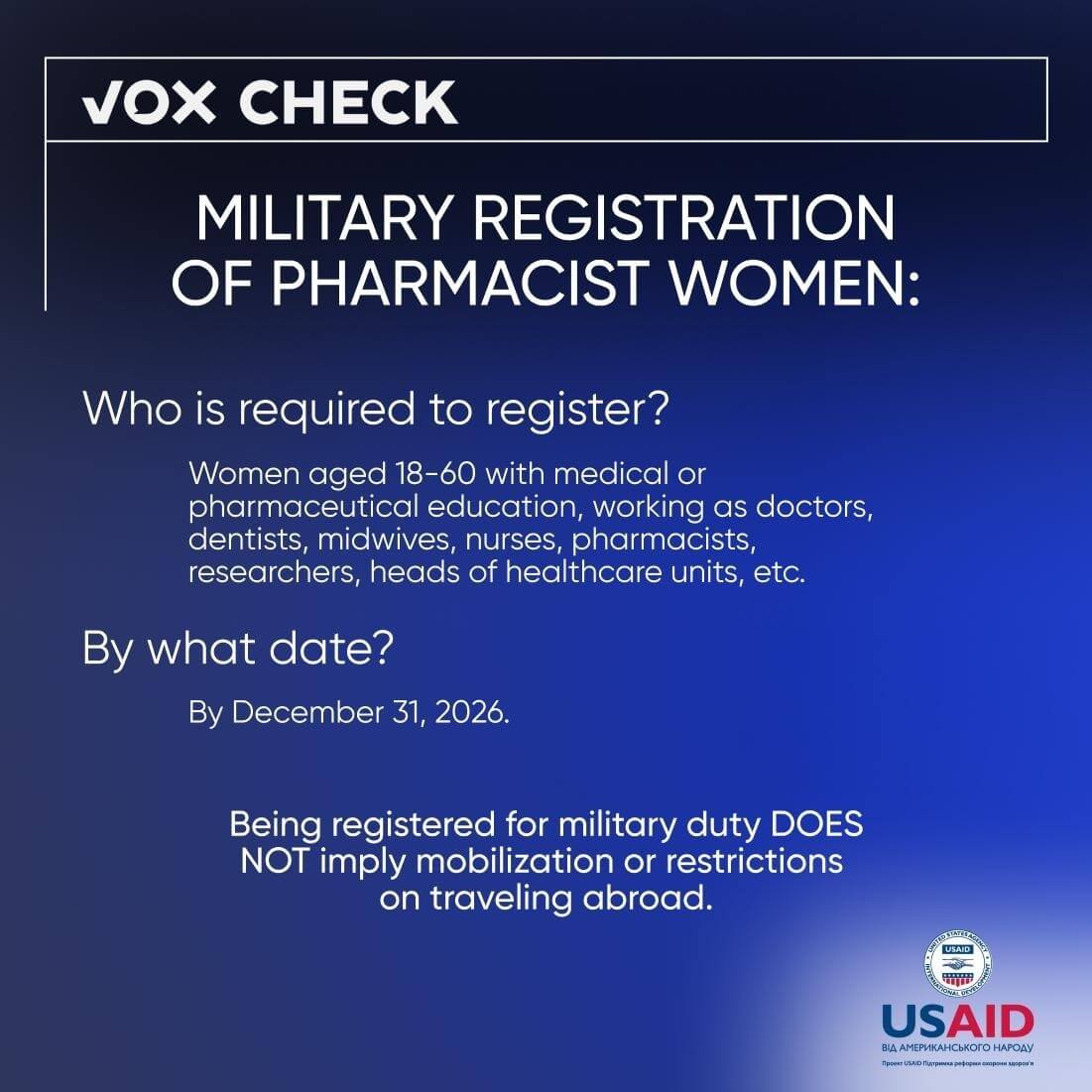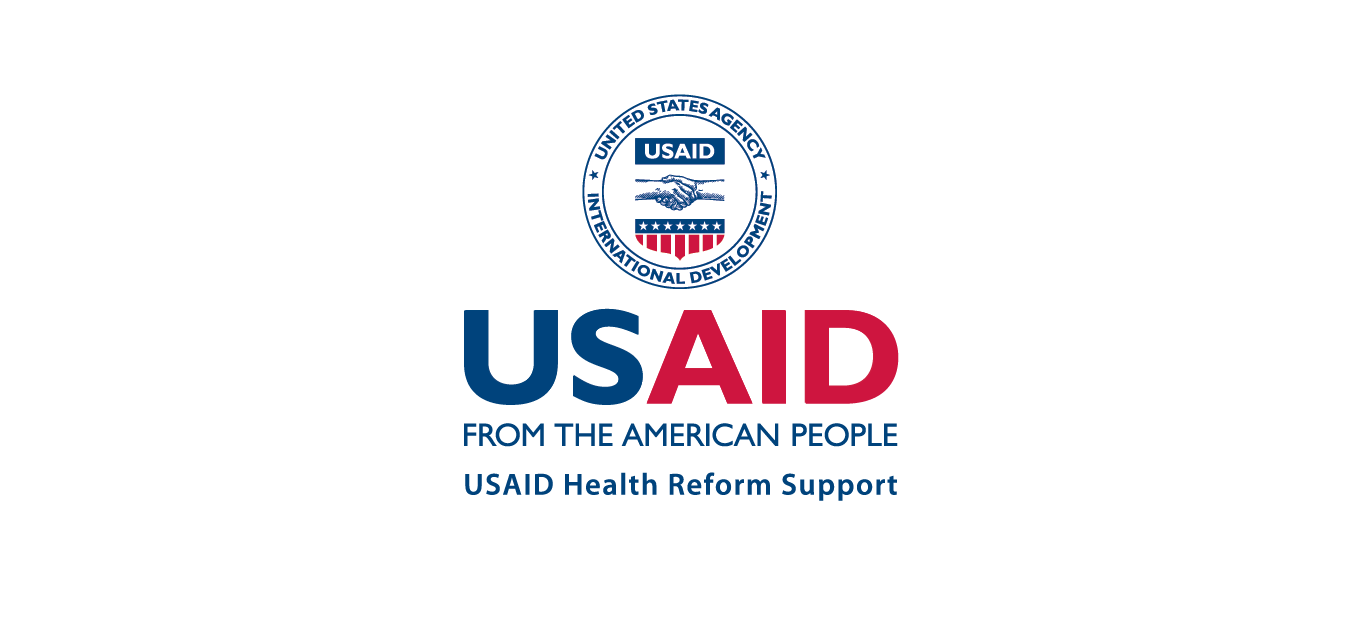In this issue, we debunked information claiming that according to official data, over 25,000 women with medical education have left Ukraine. These reports emerged due to an order to register women with relevant specialties for military service. Russian sources, attempting to sow panic in Ukrainian society, claimed that due to this new regulation, female doctors and pharmacists would be prohibited from leaving the country. Another case was dedicated to the perennial theme of Russian propaganda — bioweapons, which allegedly the US was testing in Ukraine. According to the authors of this fake, this led to the emergence of antibiotic resistance in Ukrainians.
With the support of the USAID Health Reform Support project, VoxCheck analyzes and refutes public health narratives spread in the information space of Ukraine, Belarus, and russia on a weekly basis.
Disinformation: Over 25 thousand women with medical education left Ukraine in 2 weeks
Propagandist Telegram channels are spreading information claiming that according to the State Statistics Service of Ukraine, more than 25,000 women with medical education have left Ukraine in the past two weeks. They link this to the new mandatory requirement for healthcare workers and pharmacists to register for military service. They also state that due to this registration, female medical professionals will be prohibited from traveling abroad.
What’s the reality?
The State Statistics Service does not collect or publish such statistics. At the national level in Ukraine, migration trends are tracked using several indicators: the number of arrivals and departures, along with corresponding coefficients for both. These figures are compiled on a monthly and annual basis, not weekly. Furthermore, information regarding the professions of those arriving or departing is not gathered. Data is classified by locality type, gender, age, citizenship, entry/exit countries, and countries of migrants’ birth. Additionally, the migration statistics on the State Statistics Service website have not been updated since January 2022 due to the martial law.
The State Migration Service of Ukraine also publishes statistics on population migration. However, this government agency provides information on a quarterly basis. There is no breakdown of migrants by profession in these data. As of October 2023, you can find information on the State Migration Service of Ukraine website for the first three months of 2023. In other sources, there is also no information available regarding the claim of 25 thousand women leaving Ukraine in two weeks.
As of October 1, 2023, female doctors and female pharmacists are indeed required to register for military duty, according to an order from the Ministry of Defense of Ukraine. This provision is outlined in the Law “On Military Duty and Military Service” from 1992. The Ministry of Health of Ukraine explains that due to the imperfect implementation of this provision, not all female medical professionals and pharmacists were registered for military duty in the past. Overall, the majority of female doctors and pharmacists are already registered for military duty.
Being registered for military duty does not imply mobilization or restrictions on traveling abroad. The Ministry of Health emphasizes that registration is only necessary for aggregating data about the available reserve of medical professionals in the country. However, during times of war, women who are registered for military duty may be called up for military service or engaged in defense-related tasks.
To register for military duty, women with medical or pharmaceutical specialties have a period of 3 years until December 31, 2026. Until that time, it will also be possible to get a job without a military ID. On the other hand, women who are studying in medical or pharmaceutical specialties are registered for military duty immediately upon completing their studies.
Source: Ministry of Health of Ukraine
The departure of women abroad is unrestricted, regardless of their profession or enrollment for military duty. “There are no changes related to crossing the border for women who are required to register for military duty. Restrictions continue to apply for men aged 18-60, as well as for various officials specified in government decree No. 57. This rule applies to both men and women. There are no other changes regarding restrictions on the right to travel, including for women who are required to register for military duty from October 1,” stated Andrii Demchenko, the spokesperson for the State Border Guard Service of Ukraine, during a national telethon.
Disinformation: Antibiotic-resistant infections in Ukrainians serve as evidence of bioweapon testing in Ukraine
Users, citing an article from the Financial Times, are spreading information claiming that military personnel sent abroad for treatment and Ukrainian refugees were infected with diseases in Ukrainian hospitals and then spread the infections in EU countries. According to the authors, these infections are resistant to most antibiotics, which supposedly proves that the USA is testing bioweapons in Ukraine.
What’s the reality?
The problem of antibiotic resistance in Ukraine has worsened due to the war initiated by Russia in 2014. The Financial Times article also reported that drug resistance was observed in patients worldwide. However, while high-income countries implement programs to combat this, low-income countries suffer from increased mortality due to antibiotic resistance.
Antibiotic resistance refers to the ability of bacteria to withstand the effects of antibacterial drugs, which arises from the irrational use of antibiotics (such as taking antibiotics for viral or mild bacterial infections) and not following the prescribed dosage. The best prevention of antibiotic resistance is vaccination, as the fewer illnesses a person experiences, the lower the risk of needing antibiotics.
The Financial Times article from October 2 titled “Ukrainian Infections Show Rising Threat from Antibiotic Resistance” discussed how Russia’s invasion of Ukraine in 2014 contributed to an increase in the number of drug-resistant infections in Western Europe. According to the journalists, this may have occurred due to the toxicity of heavy metals in bullets that caused injuries and deep wounds, which could lead to infections in the body, along with indiscriminate prescription of antibiotics. The situation was further complicated by the fact that healthcare facilities in conflict-affected regions were often damaged, there may have been a lack of tests to determine the correct antibiotic, and local residents who were forced to leave the region could become carriers of diseases.
The material also added that after the start of the full-scale invasion, the arrival of Ukrainian military personnel and civilians in EU countries led to a further increase in the number of antibiotic-resistant infections. “Some of the infections appear to have been acquired during stays in Ukraine’s strained hospital systems; others have been transmitted more recently within the countries receiving hundreds of thousands of refugees,“ the journalists explained. In other words, the infections occurred after February 24, 2022,
There are no U.S. biolabs in Ukraine, and no country is involved in the production or testing of bioweapons here. Furthermore, antibiotic resistance is not unique to Ukraine. The article points out that the danger of antibiotic resistance is increasing. This is happening due to the limited number of effective drugs available and the small number of drugs being developed. Additionally, existing measures such as careful selection of drugs, adherence to dosing schedules, and controlling the use of antibiotics in animal husbandry are not very effective. According to the publication, even countries that allocate a significant budget for healthcare struggle with drug resistance in patients.
The Ministry of Health of Ukraine has reported that every second patient who takes antibiotics does not actually need such treatment, and every third person uses them for viral diseases. Therefore, the fight against antibiotic resistance has been ongoing for several years.
In 2019, the Cabinet of Ministers adopted the National Action Plan to combat antimicrobial resistance. The document included provisions for implementing new methods of disease diagnosis in accordance with EU requirements. In 2021, the initiative to establish an infectious control department in healthcare institutions was also launched. The specialists in this department were responsible for monitoring antibiotics and advising doctors on the rational prescription of antibiotics in treatment.
Additionally, through the Automated Information System for Pharmacovigilance, the usage volumes of antibiotics registered in Ukraine are monitored. Starting from August 1, 2022, antibiotics began to be dispensed using electronic prescriptions. Doctors predicted that this change would not immediately improve the situation with antibiotic resistance, but over time, it would yield positive results.
Sources: Ministry of Health of Ukraine, WHO
This information piece was produced with the assistance of the United States Agency for International Development (USAID), provided on behalf of the people of the United States of America. This article’s content, which does not necessarily reflect the views of USAID, the United States Government, is the sole responsibility of Deloitte Consulting under contract #72012118C00001.
Attention
The author doesn`t work for, consult to, own shares in or receive funding from any company or organization that would benefit from this article, and have no relevant affiliations





